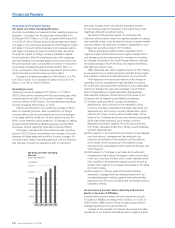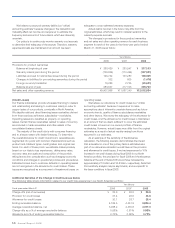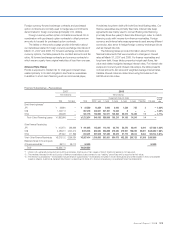Honda 2008 Annual Report Download - page 56
Download and view the complete annual report
Please find page 56 of the 2008 Honda annual report below. You can navigate through the pages in the report by either clicking on the pages listed below, or by using the keyword search tool below to find specific information within the annual report.
A n n u a l R e p o r t 2 0 0 8
5 4
Liquidity and Capital Resources
Overview of Capital Requirements, Sources and Uses
The policy of Honda is to support its business activities by
maintaining sufficient capital resources, a sufficient level of
liquidity and a sound balance sheet.
Honda’s main business is the manufacturing and sale of
motorcycles, automobiles and power products. To support
this business, it also provides retail financing and automobile
leasing services for customers, as well as wholesale financing
services for dealers.
In its manufacturing and sales business, Honda requires
operating capital mainly to purchase parts and materials
required for production, as well as to maintain inventory
of finished products and cover receivables from dealers.
Honda also requires funds for capital expenditures, mainly
to introduce new models, upgrade, rationalize and renew
production facilities, as well as to expand and reinforce Sales
and R&D facilities.
Honda meets its operating capital requirements primarily
through cash generated by operations. Honda funds its
financial programs for customers and dealers primarily from
corporate bonds, medium-term notes, commercial paper, and
securitization of finance receivables. The year-end balance of
liabilities associated with fund-raising by finance subsidiaries
was ¥4,778.9 billion as of March 31, 2008.
Cash Flows
Consolidated cash and cash equivalents for the year ended
March 31, 2008 increased by ¥105.3 billion from March 31,
2007, to ¥1,050.9 billion. The reasons for the increases or
decreases for each cash flow activity are as follows.
Net cash provided by operating activities amounted to
¥1,126.9 billion of cash inflows for the fiscal year ended March
31, 2008. Cash flow from operating activities consists of the
following main components: the major component of the
Company’s cash inflows is cash received from customers,
while the major components of the Company’s cash outflows
are payments for parts and raw materials, SG&A expenses,
and income taxes.
Compared with the prior fiscal year, cash inflows from
cash received from customers increased, due to the continued
growth in net sales because of higher unit sales in motorcycle
business in Other Regions and higher overseas unit sales in
automobile business. On the other hand, cash outflows for
payments for parts and raw materials increased, as a result
of an increase in sales units. The other reasons for increases
in cash outflows are an increase of payments for operating
expenses. However, these increases were within the range
of the growth in net sales, and because of stable operating
margins, net cash provided by operating activities increased by
¥222.3 billion compared with the previous fiscal year.
Net cash used in investing activities amounted to
¥1,686.3 billion, due mainly to capital expenditures, the
acquisitions of finance subsidiaries—receivables, which
exceeded collections of and proceeds from sales of finance
subsidiaries—receivables and the purchase of operating lease
assets. Cash outflows from investing activities increased by
¥555.6 billion compared with the previous fiscal year.
Net cash provided by financing activities amounted
to ¥688.0 billion, which was attributable to proceeds from
long-term debt and increase in short-term debt (which
exceeded repayment of long-term debt), cash dividends paid
and payment for purchase of the Company’s own stock. Cash
inflows from financing activities increased by ¥264.5 billion
compared with the previous fiscal year.
Liquidity
The ¥1,050.9 billion in cash and cash equivalents at end of
year corresponds to approximately 1.1 month of net sales,
and Honda believes it has sufficient liquidity for its business
operations.
At the same time, Honda is aware of the possibility
that various factors, such as recession-induced market
contraction and financial and foreign exchange market
volatility, may adversely affect liquidity. For this reason, finance
subsidiaries that carry total short-term borrowings of ¥2,128.4
billion have committed lines of credit equivalent to ¥923.3
billion that serve as alternative liquidity for the commercial
paper issued regularly to replace debt. Honda believes it
currently has sufficient credit limits, extended by prominent
international banks. Honda believes it has sufficient liquidity
to meet its cash obligations for the near future, at least for the
year ending March 31, 2009.
Honda’s short- and long-term debt securities are rated
by credit rating agencies, such as Moody’s Investors Service,
Inc., and Standard & Poor’s Rating Services. Based on major
current ratings, which are shown below, Honda will be able
to raise funds even if it requires more capital than its present
level of liquidity would allow.
The following table shows the ratings of Honda’s
unsecured debt securities by Moody’s and Standard & Poor’s
as of the date of the filing of Honda’s Form 20-F.
Credit Ratings for
Short-term
unsecured
debt securities
Long-term
unsecured
debt securities
Moody’s Investors Service P-1 Aa3
Standard & Poor’s Rating Services A-1 A+
The above ratings are based on information provided by
Honda and other information deemed credible by the rating
agencies. They are also based on the agencies’ assessment
of credit risk associated with designated securities issued
by Honda. Each rating agency may use different standards
for calculating Honda’s credit rating, and also makes its own
assessment. Ratings can be revised or nullified by agencies
at any time. These ratings are not meant to serve as a
recommendation for trading in or holding Honda’s unsecured
debt securities.
Off-Balance Sheet Arrangements
Special Purpose Entity
For the purpose of accelerating the receipt of cash related
to our finance receivables, we periodically securitize and sell
pools of these receivables. In these securitizations, we sell a
portfolio of finance receivables to a special purpose entity, which
is established for the limited purpose of buying and reselling
finance receivables. We remain as a servicer of the finance
receivables and are paid a servicing fee for our services. The
special purpose entity transfers the receivables to a trust or bank
conduit, which issues interest-bearing asset-backed securities
























